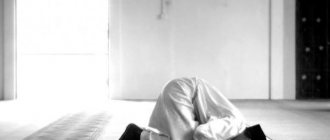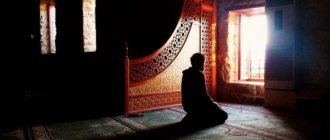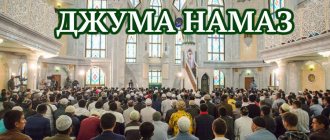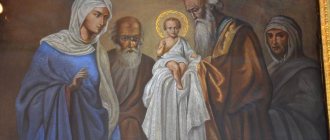- What is namaz?
- Quran about prayer
- Basics of prayer Required conditions for performing prayer
- Time of prayer
“What is namaz?” - This is one of the most frequently asked questions regarding Islam and Muslim doctrine.
Namaz (Persian نماز) is a canonical prayer in Islam, namaz translated from Arabic means prayer and is pronounced in Arabic as “as-salat” (الصلاة), and is one of the pillars of Islam.
A Muslim is required to perform a cycle of five prayers every day, which is called “fard” or “farz prayer” - these five daily prayers are obligatory for all Muslims. The performance of namaz in most of the countries of the Muslim world is not controlled, therefore, a person’s performance of prayer and adherence to all the rules and regulations of Sharia remains entirely on his conscience.
Quran about prayer
The Holy Book of the Koran does not contain clear instructions on how to perform namaz correctly, but the text of the Koran contains indications of some elements of its performance:
- time when prayers should be performed (a Muslim must perform all farz prayers at the beginning of the time and not postpone until later): what time should morning prayer be performed?
- Until what time can you do morning prayer?
- What time is lunch prayer?
- What time is afternoon prayer?
- What time do evening prayers take place?
- What time do you do night prayer?
The complete order of performing namaz gradually developed by imitating how the Prophet Muhammad ﷺ prayed, what postures he took during prayer, what movements he made. Information about these practices of performing namaz by the Prophet Muhammad ﷺ reached subsequent generations of Muslims due to the fact that the first Muslims, who were the companions of the Prophet Muhammad ﷺ, memorized this and told it to their students and followers.
A century and a half later, the Hanafi theologian Muhammad al-Shaybani recorded in writing the order of prayer. Other theologians also paid attention to the description of prayer in their writings.
What is a false dawn
There are false and true dawns. It is very important for those who perform morning prayers, as well as for those who fast, to be able to distinguish between them. False dawn has a vertical wolf-tail shape. This is the zodiacal light. It is formed as a result of the sun illuminating small particles of dust and other space objects located at the level of the ecliptic (apparent movement of the sun). It quickly disappears and the sky darkens again. The onset of true dawn is indicated by the appearance of a light horizontal stripe. The Honorable Messenger (peace and blessings of Allaah be upon him): “As for the false dawn, it is like a wolf’s tail, and at that time prayer is not permitted and food is not prohibited. And as for the dawn, which stretches along the horizon, this is the time permitted for prayer and forbidden for food! (al-Hakim). This indicates that it is impermissible to perform a religious ceremony earlier than required.
Basics of Salah
Muslim prayers differ from each other in what time and in what form they should be performed, how many rakats they consist of, and whether their performance is obligatory or desirable. The basis of namaz is rak'ah, that is, a cycle of certain postures and movements that the worshiper performs while saying prayers.
The order in which the movements and postures of the rak'ah follow one another, as well as the spoken prayer formulas, is strictly defined, and if a person violates this order, his prayer will not be counted. Adherents of all movements of Islam perform the ritual of prayer in the same way, and only representatives of extreme movements deny any ritual.
Prayer formulas are pronounced only in Arabic. In different madhhabs, some details in performing prayer differ from each other.
The place where a Muslim sits while performing namaz must be in ritual purity, called “takhara” - this concept is very important in the Muslim vocabulary. To perform prayer, you can optionally use a special mat.
While performing namaz, it is forbidden to drink and eat, talk, laugh and perform any extraneous actions not related to prayer.
It is forbidden to pray while intoxicated, delirious or intoxicated. For the disabled and sick, there are relaxations in the rules for performing namaz: depending on their physical condition, they can pray while sitting, lying down and even mentally make the necessary movements.
Mandatory conditions for performing namaz
In order for the prayer to be valid, a number of mandatory conditions must be met:
- the person praying must be in a state of ritual purity. If a Muslim is in a state of minor ritual defilement (for example, after visiting the toilet) or major (for example, after sexual intercourse), he must perform a ritual ablution: partial (after a minor defilement) or complete (after a major defilement);
- the place for performing namaz must be ritually clean;
- during prayer, a person should face the Kaaba, towards the Qibla;
- before performing namaz, a Muslim must have the intention of praying;
- The clothing of a Muslim performing namaz must be clean, not stained with impurities, and comply with Shariah standards;
- while performing prayer, a person must be of a sober mind and consciousness. Both alcohol and drugs are prohibited in Islam - they are haram;
- the times prescribed for each of the five daily obligatory prayers should be observed.
Time of prayer
There are periods of time that are prohibited for prayer:
- the time from the beginning of sunrise to the moment when the sun rises to the height of a spear;
- the period of time when the sun is at its zenith;
- at the moment when the sun sets. It is not prohibited to perform the afternoon prayer during this period of time if necessary, but the Prophet Muhammad ﷺ said that if a Muslim constantly postpones the afternoon prayer until this undesirable time, it will be a sign of hypocrisy.
A number of Islamic scholars and theologians are of the opinion that the listed prohibitions do not apply to those prayers that are performed on a specific occasion: the tahiyat al-masjid prayer, performed after entering the mosque, Kusuf and Khusuf - prayers that are performed in the event of an eclipse of the sun and an eclipse lunar, voodoo prayer, which is performed after the ritual ablution of voodoo.
These prohibitions do not apply to the obligatory daily prayers five times a day if a Muslim misses the time prescribed for him for some reason.
Elements of prayer
The bow in prayer, called “ruk’u” in Arabic.
Answering the question of what prayer is among Muslims, we should dwell in more detail on the concept of “rakaat,” which is important in the Muslim dictionary.
Rakaat is the basis of prayer, namely a cycle of poses and movements that a person must perform during prayer in a certain sequence the required number of times. These postures and movements in the rak'ah must be accompanied by the recitation of certain prayer formulas.
The order in which the worshiper pronounces prayer formulas and makes movements must be observed, and if the believer violates this order, his prayer will not be counted.
Rakaat consists of certain stages:
- First, you should raise your hands, turn your palms towards the qibla and say takbir or the formula for exalting Allah Almighty - “Allahu Akbar”;
- then you should put your right hand on your left, say Surah “Al-Fatihah”, which is the first sura in the Holy Book of the Koran, and then read any other sura or verses of the Koran;
- then one should make a ruku' or a bow, during which the words of glorification of Allah Almighty are pronounced: “Glorified is my Lord, the Majestic”;
- Having straightened up, you need to say the words tasmi': “May Allah hear the one who praised Him.” Then you should kneel down and perform sujud or prostration. In bowing, the glorifications of Allah Almighty are pronounced: “Glorified is my Lord, the Most High”;
- then you should straighten up and sit down, taking the jilsa position, and say: “My Lord, forgive me”;
- after this, you should make a second prostration and sit down. If this is the second rak'ah or the last, one should recite the tashahhud, and in the last rak'ah after the tashahhud one should say the words “Peace and mercy be upon you,” turning first to the right and then to the left.
Read more about the number of rakats and its elements for each prayer in this article.
Prostration in prayer, called “sujud” or “sajdah” in Arabic
Five daily obligatory prayers in Islam
The fard or cycle of obligatory five daily prayers includes:
- Fajr or morning, consisting of two rak'ahs;
- Zuhr or midday, consisting of four rak'ahs;
- Asr or pre-evening, consisting of four rak'ahs;
- Maghrib or evening, consisting of three rak'ahs;
- Isha or night, consisting of four rak'ahs.
In some cases, a Muslim can combine midday and evening prayers or night and evening prayers.
It is forbidden to perform namaz at the moment of zenith, and when the sun rises and sets.
It is possible to perform prayer individually or collectively, no matter where the Muslim is at that moment. When performing congregational prayers, believers must stand in rows behind the imam leading the prayer. Women should pray separately from men, standing behind them.
Moscow. Qibla direction
Distance to Kaaba? km
NEWS
Qibla direction?°
| Locality: Moscow | |
| Country Russia | Region: Moscow |
| Coordinates: 55.753960,37.620393 | Time zone: UTC+3 |
| Calculation method: Spiritual Administration of Muslims of the Russian Federation Definition of Asr (madhab): Shafi'i, Maliki, Hanbali | |
| Change settings | |
Types of prayers and their names
Collective prayer, called jamaat prayer.
Namas are fard, that is, obligatory, and sunnat, that is, desirable, which in turn are divided according to the degree of desirability. A person can voluntarily perform prayers, which are called “nafilya,” in any quantity and perform an additional night prayer, tahajjud.
The names of the prayers are given in the table below in alphabetical order:
| Name of prayer | Description |
| Asr | This is the pre-evening fard prayer, consisting of four rak'ahs. The pre-evening Asr prayer, also called the afternoon or afternoon prayer, is one of the main five prayers that must be performed daily. The time for the Asr prayer according to the Hanafi madhhab begins when the length of the shadow of an object is twice the height of the object. According to the Shafi'i, Maliki and Hanbali madhhabs, the time of the Asr prayer begins when the shadow of an object reaches the height of this object. The time for Asr prayer ends with sunset, but this time of prayer is undesirable and even sinful. In the Qur'an, Allah Almighty tells Muslims to perform prayers during: “ Protect the prayers, and especially the middle (afternoon) prayer. And stand before Allah humbly ” (2:238). If a Muslim travels, he can combine the Asr prayer with the midday prayer and shorten the Asr prayer to two rak'ahs instead of four. |
| Vitr | This is an additional prayer that should be performed after the night isha prayer is performed, during the night and before dawn. The number of rak'ahs in Witr prayer should be an odd number of times. In the month of Ramadan, Witr is performed collectively, and in other months - individually. |
| Voodoo | This prayer is performed after ablution. Dua after wudhu is a prayer that is said after performing wudhu, it can be said at any time. |
| Jamaat | This is any prayer performed collectively. Two or more persons can perform jamaat prayer. One of those performing the prayer is appointed as the imam to lead the prayer, and everyone else in the jamaat repeats all the actions after him. |
| Janaza | This is a funeral prayer. It is one of the prayers performed on a specific occasion, therefore prohibitions regarding the time of prayer do not apply to it. Janazah prayer is a fard-kifaya prayer, that is, it is obligatory for any group of Muslims (usually relatives and friends), it is performed before the burial of the body begins at a Muslim funeral. The Janaza prayer differs from the others in that it does not contain rakats, as well as in the prayers said in it. |
| Juma | This is a congregational fard prayer, which is performed collectively on Friday instead of Zuhr prayer, the midday prayer. Juma prayer on Friday must be performed in a mosque. |
| Spirit | This is the morning sunnat prayer, which is performed shortly after the sun rises before the zenith, that is, the beginning of Zuhr prayer. In the spirit of prayer, it is necessary to perform an even number of rakats: from 2 to 12 rakats. |
| Zuhr | This is the midday prayer, which is also called lunch prayer. The time for the Zuhr prayer begins shortly after the sun passes its zenith and ends with the time for the Asr prayer. Zuhr is a fard prayer, which is one of the five basic obligatory daily prayers of Muslims. |
| This is a holiday prayer, the time of which begins shortly after sunrise and ends with the time when the sun is at its zenith, on the days of Eid al-Adha and Eid al-Adha. During this prayer, in the first rak'ah, before reading Surah Al-Fatiha, the takbir is said seven times. | |
| Istiqa-prayer | Muslims perform this prayer during periods of drought; it is a sunnat prayer, performed collectively to offer prayers to the Lord to send rain. |
| Istikhara | This prayer can be performed at any time; it is a sunnat prayer that is performed to ask the Lord for help in making the right decision. |
| Isha | This is a night prayer of 4 rak'ahs, which is one of the five daily obligatory prayers of Muslims. This fard prayer is performed after the end of the evening prayer time. The time for performing Isha lasts until midnight (most preferably) or until dawn. |
| Qasr | Combining two prayers. This can be done for Muslims who are on the move. |
| Kusuf | This is a prayer performed when a solar eclipse occurs. This is a group sunnat prayer. |
| Qiyamu-leil | This is the night prayer performed after the Isha prayer before the morning prayer. Qiyamu layl is also tahajjud prayer. |
| Maghreb | This is an evening prayer of three rak'ahs, which is one of the five times obligatory daily prayers of Muslims. The time for performing Maghrib lasts from sunset until the time of night Isha prayer, but it is important to perform Maghrib prayer immediately at the beginning of its time. |
| Ratibat / Sunnat | This is an additional prayer that a Muslim should perform before and after one of the obligatory prayers. |
| Tarawih | This is a sunnat prayer that is performed during the month of Ramadan after night prayer. |
| Tahajjud | This is a sunnat prayer, which a Muslim can also perform after night prayer after sleeping, the desired time for performing this prayer is the last third of the night, which will differ in time depending on the place and month of the Muslim calendar. |
| Tahiyat-ul-masjid | Namaz, which involves greeting the mosque: a Muslim should perform it after entering the mosque. |
| Fajr | This is the dawn prayer, the time of which begins every day at dawn and ends at sunrise. It is one of the obligatory daily prayers. |
| Hauf | This is a prayer that Muslims perform during war and is considered a prayer of fear. Done collectively. |
| Khusuf | A prayer that is performed when a lunar eclipse occurs. This is a group type of sunnat prayer. |
Mosques, prayer rooms, halal cafes
Addresses of mosques in Moscow:
- st. Bolshaya Tatarskaya, 28
- st. Minskaya, 2b “Mosque on Poklonnaya Hill”
- Vypolzov Lane. lane d.7 Cathedral Mosque
- st. Khachaturyan, 8
- Shchelkovo, st. Sovetskaya, 10
- Podolsk, Domodedovskoe highway, 35a
- Balashikha, st. Pervomaiskaya, 7
- Noginsk, st. Yuzhnaya, 35
Prayer rooms
Addresses of prayer rooms in Moscow:
- Komsomolskaya sq. Kazan Station
- Sheremetyevo airport
- Domodedovo Airport 2nd floor
- Vnukovo Airport 2nd floor
- Lyubertsy, st. Yuzhnaya, no. 10
- w. Entuziastov 33 building 10
- st. Garibaldi 56
- metro station Lyublino, Sadovod market, row 13
- st. Admirala Lazarev 26, “Mercy”
- st. Lenina, 25-a
- st. Klochkova, 10, prayer room in the Ansar cafe
- st. Zelenodolskaya 12
- st. Glavmosstroy, 3
Halal cafe
Addresses of halal restaurants:
- MKAD, 32nd kilometer, vl4, Luzhayka shopping center, cafe “ZAM-ZAM”
- st. Novocherkassky Boulevard, 57k2 (Maryino metro station) “Chaikhana Dolina”
- st. Klochkova, 10, cafe "Ansar"
- Leninsky Prospekt, 148, “Bashlam”
- Signalny proezd 9b, Tea-bar
- Taganskaya sq. d.88
- Dmitrovskoe highway building 30
- w. Entuziastov 33 building 10
- st. Veernaya, 3k6
- Ryazansky Prospekt, 46 bldg. 6
- Lianozovsky pr-d vl.1-a
- st. Lesnaya, 1
- m. Shchukinskaya, Shchuka shopping center.
Azan in Moscow
Watch the video. Video schedule for November! Listen to the beautiful Azan until the end. How beautiful is this call!
If you do not have the opportunity to watch the sunrise or sunset on the horizon, then this page of the site will be useful for you.
If you find errors and cannot find data for your city, write about it in the comments. After some time, the settlement will be added, in Allah.








